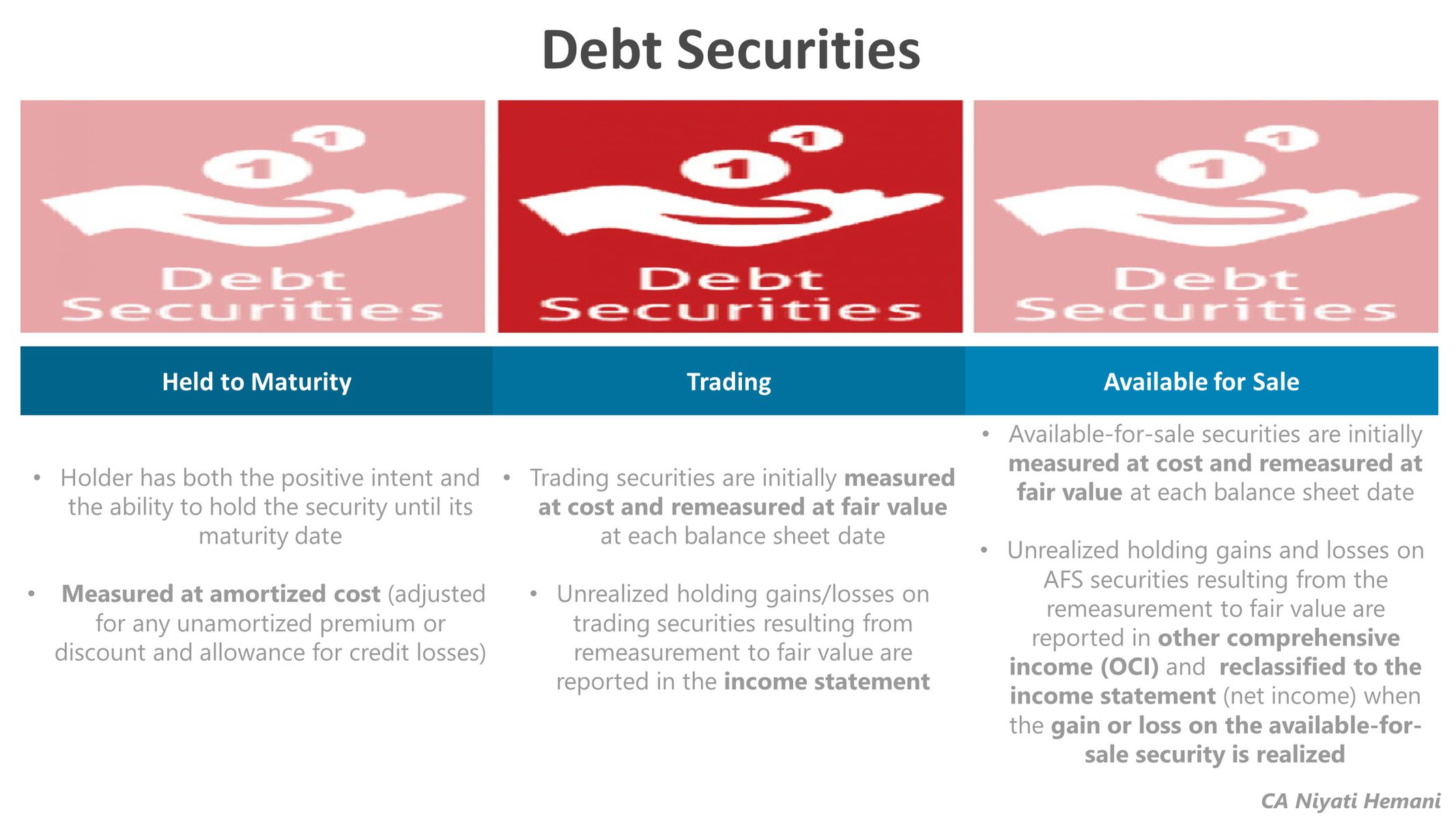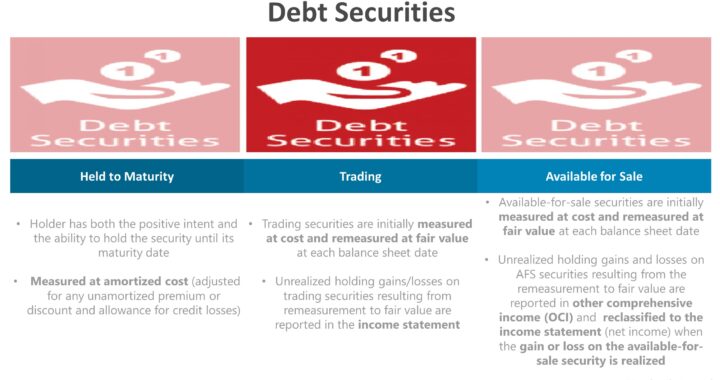
A debt security represents a creditor relationship with the issuer
In addition to the common forms of debt, this category includes:
- Mandatorily redeemable preferred stock
- Preferred stock redeemable at the investor's option
- Collateralized mortgage obligations
Classification
Debt securities are classified at acquisition into one of the three categories. The classification is reassessed at each reporting date
Category Criteria
Held to Maturity Debt securities that the reporting entity has the positive intent and ability to hold to maturity
Trading Debt securities intended to be sold in the near term
Available-for-sale Debt securities not classified as held-to-maturity or trading
Held to Maturity (HTM)
- HTM securities are reported at amortized cost
- HTM securities are presented net of any unamortized premium or discount
- In Balance Sheet - Individual securities are presented as current or noncurrent
- The income statement includes Interest Income (including amortization of premium or discount) and Realized gains and losses
- Cash Flows are from Investing Activities
Trading Securities
- Trading security is recorded at cost (including brokerage commission and taxes)
- At each balance sheet date, trading securities are remeasured at fair value
- Unrealized holding gains and losses are reported in the income statement
- To retain historical cost in the accounts while reporting changes in the carrying value arising from changes in fair value, a valuation account for each security may be established
- If valuation account is maintained, debit "Fair Value" Adjustment Account (Trading) instead of directly debiting Trading Securities Account
- In Balance Sheet - Trading securities are reported at fair value under current assets
- The income statement includes - a) Interest Income (including amortization of premium or discount), b) Dividends (in case of redeemable preferred stock), c) Unrealized holding gains and losses, d) Realized holding gains and losses
- Cash Flows from Operating Activities
Available for Sale Securities
- Securities that are neither classified as trading securities nor held to maturity are considered as available for sale
- They are initially recorded at cost
- At each balance sheet date, AFS securities are remeasured at fair value
- Unrealized holding gains and losses resulting from the remeasurement are reported in OTHER COMPREHENSIVE INCOME until realized
- Tax effects are debited/credited directly to OCI
- Receipt of cash dividends is recorded by a credit to dividend income
- In the cash flow statement, it is shown under investing activities section
- In Balance Sheet - AFS securities are reported at a) fair value b) under current assets or noncurrent
- Unrealized holding gains and losses are reported in accumulated OCI in the equity section
- The income statement includes - a) Interest Income (including amortization of premium or discount), b) Dividends (in case of mandatorily redeemable preferred stock), c) Realized holding gains and losses
- Reclassification adjustment for each component of OCI - The purpose is to avoid double-counting when an item included in net income also was included in OCI for the same period or prior period. Eg. If a gain on available for sale security is realized in the current period, the prior period recognition of an unrealized holding gain must be eliminated by Debit to Other Comprehensive Income and Credit Gain
- Cash flows are from Investing Activities
Summary
Held to Maturity Trading Securities Available for Sale Securities
Intent Positive Intent and Sell in near future All others (residual category)
ability to hold
Balance Sheet Current or Non-Current Current only Current or Non-Current
Carrying Amount Amortized Cost Fair Value Fair Value
Unrealized Holding
Gain / Loss NA Income statement Other comprehensive income
Cash Flow Activity Investing Operating Investing
Earnings from Interest,
Amortization Income statement Income statement Income statement
Impairment
Permanent decline in fair value of either the held-to-maturity or available-for-sale securities should be recognized as a realised loss
- The cost should be written down to fair value which becomes the new cost basis
- Such a write down is deemed to be a realized loss and hence, should be included in net income
- The new cost basis is not affected by subsequent recoveries in fair value
- Subsequent changes in fair value of available for sale securities are included in OCI
If you have found this blog to be useful, you may share with your friends. Thanks!



